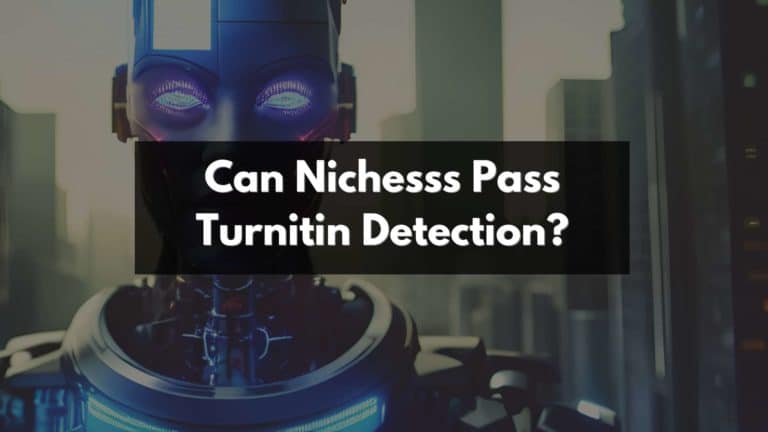Can Neuroflash Pass Turnitin Detection?
Curiosity about AI technology’s ability to dodge plagiarism detection systems is sparking discussions. For instance, Turnitin, a leading plagiarism scanning tool used in academic circles has been put to the test with Neuroflash.
This blog post aims to shed light on this complex issue and provide clear information based on recent findings. Ready for a deep dive into the world of AI writing and plagiarism detection?.
Key Takeaways
- Turnitin’s AI writing detection capability is widely used in academia to identify instances of plagiarism, but it may not always accurately detect content generated by advanced AI tools like Neuroflash.
- Detecting AI – generated content presents challenges for plagiarism detection tools due to complex rewording and paraphrasing techniques used by users.
- Instructors can use the similarity index and originality report provided by Turnitin, as well as other AI detection tools, to help identify the use of ChatGPT or other AI models. However, these methods have limitations and should be supplemented with manual inspection and citation analysis to ensure academic integrity.
Understanding AI Writing Detection
Turnitin’s AI writing detection capability is widely used by academics to identify instances of plagiarism in essays and scientific papers.
Turnitin’s AI writing detection capability
Turnitin is no ordinary checker; it’s the holy grail of plagiarism detection used widely by academic institutions. What sets Turnitin apart from typical checkers? It’s innovative AI writing detection capabilities.
This tool dives deeper than just a surface scan for identical content on the internet. Powered with advanced technology, it identifies swapped words, slightly altered sentences and even cleverly reworded paragraphs – things an average scanner might miss.
Additionally, Turnitin has moved beyond detecting copy-paste jobs to identifying AI-assisted writing techniques that students may use to dupe the system. Its sophisticated algorithm can detect work generated by ChatGPT or any other advanced AI-based tool nonetheless there are fallouts and hence cannot guarantee catching all instances of plagiarism as indicated in our facts above where WordHero was able to pass Originality.ai detection but only to some extent.
The question that follows: Is any essay safe from its scrutinizing gaze? Well… that remains a topic of intense debate.
Limitations and false positives
Turnitin’s AI writing detection capability, while advanced, does have its limitations and can sometimes yield false positives. While the software is designed to detect instances of plagiarism, it may not always accurately identify content generated by AI writing tools like Neuroflash.
This can be due to several factors such as the complexity of the AI-generated text or the unique algorithms used by these tools.
False positives are a common issue with any plagiarism detection tool, including Turnitin. In some cases, legitimate content might be flagged as plagiarized when it is actually original.
This can occur when there are similarities in language use or specific phrases that appear in both sources but are coincidental rather than intentionally copied.
Ethical implications
The use of AI writing detection tools, like Turnitin, raises important ethical considerations. While these tools are designed to detect instances of plagiarism and promote academic integrity, they can also create false positives and limit the creative potential of students using AI-assisted writing tools like Neuroflash.
Ethical concerns arise when AI-generated content is falsely flagged as plagiarized or when students feel discouraged from utilizing AI writing tools due to the fear of being detected by such systems.
It is crucial for educators and institutions to strike a balance between preventing plagiarism and fostering innovation in the digital age.
Can Neuroflash Pass Turnitin Detection?
Neuroflash’s ability to pass Turnitin detection is being put to the test.
Potential of AI writing detection
AI writing detection has the potential to greatly impact the way we identify and prevent plagiarism. With advancements in AI technology, tools like Turnitin can detect various types of AI-generated content and flag instances of potential cheating.
However, it’s important to note that these detection systems have limitations and may not catch all cases of AI-assisted writing. While Turnitin’s capabilities go beyond just ChatGPT, there are still challenges in detecting AI-generated content due to complex rewording and paraphrasing techniques used by users.
Despite these challenges, researchers continue to develop new methods for improving AI detection technology and ensuring academic integrity.
Challenges in detecting AI-generated content
Detecting AI-generated content poses significant challenges for plagiarism detection tools like Turnitin. With advancements in natural language processing technology, AI writing tools can now generate content that closely mimics human writing styles and patterns.
This makes it increasingly difficult for software to differentiate between original work and AI-generated content.
One of the main challenges is the ability of AI algorithms to reword or paraphrase existing text, making it appear as new and unique content. Turnitin relies on a database of previously submitted works to detect similarities in language, structure, and ideas.
However, when an AI tool modifies the original text sufficiently, it becomes challenging for Turnitin to identify plagiarism accurately.
Moreover, there are various AI writing tools available today that have different algorithms and techniques for generating content. Turnitin’s detection capabilities primarily focus on ChatGPT but might struggle with other advanced models like Quillbot or Neuroflash.
As a result, these new tools may bypass traditional plagiarism checks.
Additionally, some students may intentionally manipulate their texts by applying slight modifications such as changing word order or using synonyms to evade detection by Turnitin’s algorithm.
Detection of ChatGPT
ChatGPT is an AI language model that has gained popularity for generating human-like text. However, the question arises: can ChatGPT bypass AI content detection? Detecting content generated by ChatGPT can be a challenging task for plagiarism scanners like Turnitin.
While Turnitin’s detection capabilities extend beyond just ChatGPT, it may struggle to identify instances where text has been generated using this specific AI model. This poses significant concerns regarding academic integrity and the ability of educational institutions to detect and prevent plagiarism effectively.
With the rise in sophisticated AI writing tools, it becomes crucial for instructors and educators to explore alternative approaches in order to ensure authenticity and maintain academic honesty.
How Can Instructors Detect the Use of ChatGPT?
Instructors can detect the use of ChatGPT through various methods such as checking the similarity index and originality report provided by Turnitin, using AI detection tools specifically designed to identify AI-generated content, and conducting citation analysis to ensure content authenticity.
Discover effective ways to uphold academic integrity and catch instances of plagiarism in this article.
Similarity index and originality report
Turnitin provides a similarity index and an originality report when checking for plagiarism in academic work. These features are essential for identifying instances of copied content and ensuring academic integrity.
AI detection tools
- Turnitin is one of the leading AI detection tools used to check for plagiarism in academic papers and essays.
- It analyzes the text and compares it to a vast database of sources to identify any similarities or instances of copied content.
- Turnitin’s AI technology can detect not only direct copy – pasting but also paraphrasing and rewording attempts, making it difficult to bypass.
- The tool provides a similarity index and an originality report that highlight potential plagiarized sections in the submitted work.
- While Turnitin is effective at detecting most cases of plagiarism, it may still have limitations and false positives.
- Some instances of AI – generated content, like ChatGPT, may be challenging for Turnitin to detect as they generate unique outputs that may not match existing sources in its database.
- However, Turnitin continually updates its detection capabilities to stay ahead of evolving AI technologies.
- Other AI detection tools similar to Turnitin include Quillbot and Originality.ai, which offer additional features like paraphrase detection and content authenticity analysis.
- It is important for instructors to use a combination of AI detection tools along with manual inspection and citation analysis to ensure academic integrity.
- Students should be aware that attempting to cheat Turnitin or any other AI detection tool is considered academic dishonesty and can have severe consequences on their academic record.
- While there may be methods available to cheat Turnitin, such practices are unethical and undermine the purpose of education.
Please note that cheating or attempting to cheat any form of plagiarism detection software is highly unethical. This article merely highlights the capabilities and limitations of AI detection tools for informational purposes only. It is crucial for students, writers, and researchers to uphold ethical standards when producing their work.
Conclusion
In conclusion, while Turnitin’s AI writing detection capabilities are impressive, they do have limitations when it comes to detecting AI-generated content like Neuroflash or ChatGPT.
However, instructors can still use various methods such as similarity index and originality reports to identify potential plagiarism. It is important for students to understand the ethical implications of using AI-assisted writing tools and strive for academic integrity by properly citing sources and avoiding any form of cheating.
FAQs
1. Can Neuroflash help me bypass Turnitin detection?
No, Neuroflash cannot help you bypass Turnitin detection. Turnitin is a sophisticated plagiarism detection tool that is designed to identify copied or unoriginal content in academic papers.
2. How does Turnitin detect plagiarism?
Turnitin uses a large database of academic papers, journals, and websites to compare the submitted paper against existing content. It checks for similarities in sentence structure, word choice, and overall writing style to identify potential instances of plagiarism.
3. Is it safe to use Neuroflash for my academic papers?
Using any software or service that claims to bypass or cheat plagiarism detection tools like Turnitin is not recommended and can have serious consequences. It can lead to academic penalties such as failing grades, suspension, or even expulsion from your educational institution.
4. What are some ethical alternatives to using Neuroflash?
Instead of trying to cheat the system, focus on developing good research and writing skills. Properly cite all sources used in your paper and give credit where it’s due. If you need assistance with writing or citing sources, consult with your teachers or utilize legitimate resources such as citation guides provided by reputable institutions like Purdue OWL.



